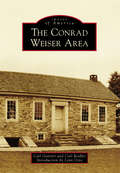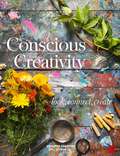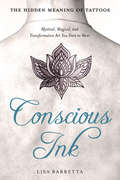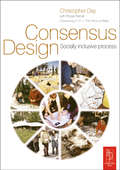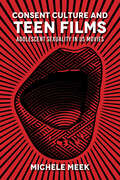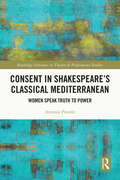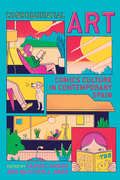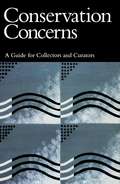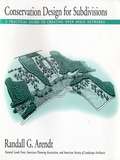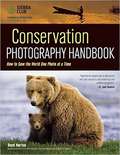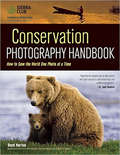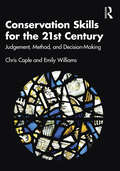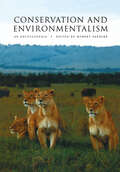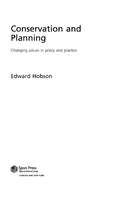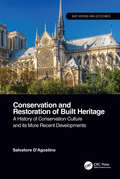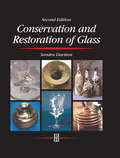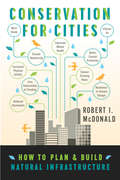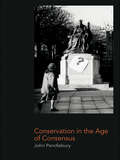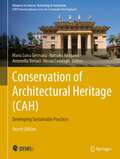- Table View
- List View
Conrad Weiser Area, The
by Carl Ganster Lynn Otto Carl ReidlerIn 1729, John Conrad Weiser, the most famous citizen of the area, joined his fellow Germans and built his homestead just east of present-day Womelsdorf. The settlement grew in the 1800s with a turnpike, a canal, a railroad, and more highways. Villages were started, and three became boroughs. Womelsdorf is the oldest borough in the western part of Berks County, while Robesonia and Wernersville were railroad towns laid out in the 1850s. Some remain villages to this day. Stouchsburg grew up around the turnpike and the canal. Charming Forge was the first industry in the area, and the village still looks like it did 200 years ago. The remaining parts of the area are rural, and some of the best growing soil is found in the Conrad Weiser area. In 1954, seven municipalities joined to form the Conrad Weiser Area School District. This book covers photographs from 1900 until the 1960s and includes all municipalities.
Conscious Creativity: Look, Connect, Create
by Philippa StantonA self-help book for artists “crammed with practical ideas, inspirational images and creative exercises . . . establishing what kind of creative you are”(Mslexia).Unlock your creative potential with Conscious Creativity: a practical, playful guide bursting with inspiration to help bring more color into to your life. There is creativity in all of us, but it can easily be buried beneath our everyday concerns. Whether you’ve lost your mojo or just need some fresh ideas, artist and photographer Philippa Stanton’s lively guide will stimulate your imagination and reinvigorate your creative life.Engage your curiosity and connect your observations to your creative practice with activities such as:Noticing all the hues of one color you can see around youCreating an abstract textured image using herbs, spices and other dry ingredients from your kitchen cupboardsCollecting shadows: photograph hidden shapes and dark spaces that you haven’t noticed beforeConscious Creativity will help you open your senses to the beauty you may not notice every day, and show you how to capture it. Simple, engaging exercises that encourage observation and experimentation will give you an insight into your own aesthetics as you take a conscious step to note the colors, shapes, shadows, sounds and textures that fill your world, and how they make you feel.Embrace the joy of creating and learn to use your natural curiosity to take a leap into the most creative time of your life.“Full of tips and tricks on how to look at the world with a curious eye, it’s a brilliant way to breathe creativity (back) into our lives.” —Flow magazine
Conscious Ink: Mystical, Magical, and Transformative Art You Dare to Wear
by Lisa BarrettaThere is hidden, powerful wisdom in tattoos. Did you ever think of your tattoo as a charged body talisman or a portal into your spiritual self? Ancient cultures practicing shamanic tattooing laid the groundwork for our modern exploration of consciousness. Tattoos are both a revelation and a proclamation of your embodied archetypes, dreams, emotions, even a hint of past-life memories.Conscious Ink shows how this edgy skin art interfaces with our body’s subtle energy field and reveals how tattoo imagery ties into the potent energy of inner alchemy that expands our self-awareness.Are you prepared to:Find out how/why intention is the moving force behind your tattoo’s vibration? Do you bring on good luck or bad juju?Understand why the piercing of your skin and drawing of blood forms a symbolic link into the energy field of your tattooist?Explore how tattoos reveal past-life/current-life emotional memory?Discover how tattoos can shift the emotional energy stored in certain body areas?Mindful inking can be an amazing modality that awakens your spiritual self. Looking at tattoos beyond the lens of body art, Conscious Ink gives you a new perspective on tattoos and their undeniable roots in pure, magic and mysticism.
Consensus Design
by Christopher Day Rosie ParnellConsensus Design offers a practical step by step guide to co-design; an increasingly important consideration for architects as they compete for work.The text moves from identifying the methodology of the process to developing a series of principles and practical steps which illustrate how consensus design can be established. For easy reference, flow charts show the process of achieving consensus design and include variations for different types of project and different groups of people. It gives clear timings so that agreements can be reached within a specific time frame, and also features a number of case studies to illustrate consensus design principles in practice. Case studies include projects in the UK, US, and Sweden.Consensus design isn't just a utopian ideal. It's the only meaningful way in which people can be involved in shaping where they live and work. It can have an influence on social stability, crime-reduction, personal health and building longevity, all of which in turn have monetary and environmental cost implications. Its consideration can also greatly help architects win work and commissions.Day argues that when places are designed by professionals for people, many things obvious to the residents are overlooked. When they are designed by lay people, the design can suffer from the lowest common denominator factor. When places are designed by both it tends to end up in conflict. However, Consensus Design shows that co-design is not doomed to either conflict or banality if it is managed correctly.
Consent Culture and Teen Films: Adolescent Sexuality in US Movies
by Michele MeekTeen films of the 1980s were notorious for treating consent as irrelevant, with scenes of boys spying in girls' locker rooms and tricking girls into sex. While contemporary movies now routinely prioritize consent, ensure date rape is no longer a joke, and celebrate girls' desires, sexual consent remains a problematic and often elusive ideal in teen films.In Consent Culture and Teen Films, Michele Meek traces the history of adolescent sexuality in US cinema and examines how several films from the 2000s, including Blockers, To All the Boys I've Loved Before, The Kissing Booth, and Alex Strangelove, take consent into account. Yet, at the same time, Meek reveals that teen films expose how affirmative consent ("yes means yes") fails to protect youth from unwanted and unpleasant sexual encounters. By highlighting ambiguous sexual interactions in teen films—such as girls' failure to obtain consent from boys, queer teens subjected to conversion therapy camps, and youth manipulated into sexual relationships with adults—Meek unravels some of consent's intricacies rather than relying on oversimplification.By exposing affirmative consent in teen films as gendered, heteronormative, and cis-centered, Consent Culture and Teen Films suggests we must continue building a more inclusive consent framework that normalizes youth sexual desire and agency with all its complexities and ambivalences.
Consent in Shakespeare: What Women Do and Don’t Say and Do in Shakespeare’s Mediterranean Comedies and Origin Stories (Studies in Performance and Early Modern Drama)
by Artemis PreeshlBy examining how female characters speak and act during coming of age, engagement, marriage, and intimacy, Consent in Shakespeare will enhance understanding about how and why women spoke, remained silent, or acted as they did in relation to their intimate partners in Early Modern and contemporary private and public situations in and around the Mediterranean. Consent in intimate relationships is front and center in today’s conversations. This book re-examines the verbal and physical interactions of female-identified characters in Early Modern and contemporary cultures in Shakespeare’s Mediterranean comedies and the sources from which he derived his plays. This re-examination of the words that women say or do not say, and actions that women do or do not take, in Shakespeare’s Mediterranean plays and his probable sources sheds light on how Shakespeare’s audiences might have perceived Mediterranean cultural mores and norms. Assessment of source materials for Shakespeare’s comedies set in the Balkans, France, Italy, the Near East, North Africa, and Spain suggests how women of diverse backgrounds communicated in everyday life and peak life experiences in the Early Modern era. Given Shakespeare’s impact worldwide, this initiative to shift the conversation about the power of consent of female protagonists and supporting characters in Shakespeare’s Mediterranean plays will further transform conversations about consent in class, board and conference rooms, and the international stage.
Consent in Shakespeare’s Classical Mediterranean: Women Speak Truth to Power (Routledge Advances in Theatre & Performance Studies)
by Artemis PreeshlConsent in Shakespeare’s Classical Mediterranean fills a gap in knowledge about how female-identified, gender-fluid, and non-binary characters made choices about intimacy, engagement, and marriage in Shakespeare’s classical Mediterranean plays.This classical sequel explores how female-identified, gender-fluid, and non-binary characters accessed agency in Shakespeare’s Mediterranean plays set in classical Troy, Athens, Thebes, Antioch, Ephesus, Mytilene, the North African Pentapolis, Tarsus, Egypt, Rome, Antium, Britain, Sardis, Philippi, Sicily, greater Bohemia, and the Balkan region. Through the lens of sources from Eastern and Western Europe, the Middle East, and the Maghrib, Shakespeare’s heroines and their supporters may have initially appeared to conform to Early Modern contexts, but the diverse backgrounds of female-identified, gender-fluid, and non-binary characters impacted the right to consent to friendship, affection, betrothal, and marriage in the classical Mediterranean. By focusing on perspective views about female-identified, gender-fluid, and non-binary characters in and around Eastern and Western Europe, the Middle East, and the Maghreb, classical realities collide with Early Modern preconceptions and misconceptions to reveal commonalities and differences in the lived experiences of female-identified and non-binary royalty, nobility, servants, enslaved peoples, matchmakers, courtesans, sex workers, madams, herbalists, tailors, and merchants.This study will be of great interest to students and scholars in Theatre, Middle East Studies, Asian Studies, Eastern European and Eurasian Studies, African and Maghrib Studies, and Social Justice Studies.
Consequential Art: Comics Culture in Contemporary Spain (Toronto Iberic)
by Samuel Amago Matthew J. MarrSpanish comics have attracted considerable critical attention internationally: dissertations have been written, monographs have been published, and an array of cultural institutions in Spain (the media, publishing houses, bookstores, museums, and archives) have increasingly promoted the pleasures, pertinence, and power of graphic narrative to an ever-expanding readership – all in an area of cultural production that was held, until recently, to be the stuff of child’s play, the unenlightened, or the unsophisticated. This volume takes up the charge of examining how contemporary comics in Spain have confronted questions of cultural legitimacy through serious and timely engagement with diverse themes, forms, and approaches – a collective undertaking that, while keenly in step with transnational theoretical trends, foregrounds local, regional, and national dimensions particular to the late twentieth- and early twenty-first-century Spanish milieu. From memory and history to the economic and the political, and from the body and personal space to mental geography, the essays collected in Consequential Art account for several key ways in which a range of comics practitioners have deployed the image-text connection and alternative methods of seeing to interrogate some of the most significant cultural issues in Spain.
Conservation
by Alison Richmond Alison Bracker'Conservation: Principles, Dilemmas, and Uncomfortable Truths' presents multi-perspective critical analyses of the ethics and principles that guide the conservation of works of art and design, archaeological artefacts, buildings, monuments, and heritage sites on behalf of society. Contributors from the fields of philosophy, sociology, history, art and design history, museology, conservation, architecture, and planning and public policy address a wide range of conservation principles, practices, and theories from the US, Canada, Europe, Australia and New Zealand, encouraging the reader to make comparisons across subjects and disciplines. By wrestling with and offering ways of disentangling the ethical dilemmas confronting those who maintain and sustain cultural heritage for today and tomorrow, 'Conservation: Principles, Dilemmas, and Uncomfortable Truths' provides an essential reference text for conservation professionals, museum and heritage professionals, art and cultural historians, lecturers and students, and all others invested in cultural heritage theories and practices. Alison Richmond, as a Senior Conservator in the Victoria and Albert Museum and Deputy Head of the Conservation Department at the Royal College of Art, maintains teaching and research roles in conservation theory, principles and ethics, and has developed decision-making tools for conservators. She is an Accredited Conservator-Restorer (ACR), a Fellow of the International Institute for Conservation (FIIC), and a Trustee of the UK’s Institute of Conservation (Icon) since 2005. Alison Bracker received her PhD in the History of Art from the University of Leeds, and manages the Events & Lectures programme at the Royal Academy of Arts in London. As co-founder of Bracker Fiske Consultants, she advises on the presentation, description, documentation, and care of artworks comprising modern media, and lectures and publishes widely on the theoretical and practical issues arising from the conservation of non-traditional and impermanent materials in contemporary works of art.
Conservation Concerns: A Guide for Collectors and Curators
by Konstanze BachmannWritten in accessible, nontechnical language, this book's twenty-three essays provide invaluable conservation guidelines for a variety of materials and media. Focusing also on proper storage techniques and environmental control, contributors offer information on emergency planning, disaster management, and identifying damages that may require professional treatment.From the Trade Paperback edition.
Conservation Design for Subdivisions: A Practical Guide To Creating Open Space Networks
by Randall G. ArendtIn most communities, land use regulations are based on a limited model that allows for only one end result: the production of more and more suburbia, composed of endless subdivisions and shopping centers, that ultimately covers every bit of countryside with "improvements." Fortunately, sensible alternatives to this approach do exist, and methods of developing land while at the same time conserving natural areas are available. In Conservation Design for Subdivisions, Randall G. Arendt explores better ways of designing new residential developments than we have typically seen in our communities. He presents a practical handbook for residential developers, site designers, local officials, and landowners that explains how to implement new ideas about land-use planning and environmental protection. Abundantly illustrated with site plans (many of them in color), floor plans, photographs, and renditions of houses and landscapes, it describes a series of simple and straightforward techniques that allows for land-conserving development. The author proposes a step-by-step approach to conserving natural areas by rearranging density on each development parcel as it is being planned so that only half (or less) of the buildable land is turned into houselots and streets. Homes are built in a less land-consumptive manner that allows the balance of property to be permanently protected and added to an interconnected network of green spaces and green corridors. Included in the volume are model zoning and subdivision ordinance provisions that can help citizens and local officials implement these innovative design ideas.
Conservation Directory 2015: The Guide to Worldwide Environmental Organizations
by Arlander C. BrownThe authority on natural resource use and management agencies around the world.Do you want to take action to protect Earth’s environment? Are you interested in learning more about wildlife conservation and environmental groups? The Conservation Directory 2015 is a great resource for budding environmental activists and scholars alike who want to achieve a peaceful, equitable, and sustainable future. This all-inclusive volume is an amazing resource that can help further these environmental goals.The new and revised 2015 edition of the Conservation Directory is the most comprehensive listing of conservation and environmental organizations yet published, with information on more than four thousand government agencies, nongovernmental organizations, and colleges and universities, as well as more than eighteen thousand officials concerned with environmental conservation, education, and natural resource use and management.Each entry contains detailed contact information, including names, addresses, and telephone numbers. Also included are selected email and Internet addresses, descriptions of program areas, senior staff by name and responsibility, principal publications, and more. Entries are categorized by organization and state or country and are indexed alphabetically and by subject on topics ranging from acid rain to zoology. Each person listed in the directory is also indexed alphabetically.
Conservation Directory 2017: The Guide to Worldwide Environmental Organizations
by Lindsey BreuerDo you want to take action to protect Earth’s environment? Are you interested in learning more about wildlife conservation and environmental groups? The Conservation Directory 2017 is a great resource for budding environmental activists and scholars alike who want to achieve a peaceful, equitable, and sustainable future. This all-inclusive volume is an amazing resource that can help further these environmental goals.The new and revised 2017 edition of the Conservation Directory is the most comprehensive listing of conservation and environmental organizations yet published, with information on more than four thousand government agencies, nongovernmental organizations, and colleges and universities, as well as more than eighteen thousand officials concerned with environmental conservation, education, and natural resource use and management.Each entry contains detailed contact information, including names, addresses, and telephone numbers. Also included are selected email and Internet addresses, descriptions of program areas, senior staff by name and responsibility, principal publications, and more. Entries are categorized by organization and state or country and are indexed alphabetically and by subject on topics ranging from acid rain to zoology. Each person listed in the directory is also indexed alphabetically.
Conservation Photography Handbook: How To Save The World One Photo At A Time
by Boyd NortonThis book is a call to action, providing the tools photographers need to help preserve threatened species and environments around the world or in their own backyards. Author/photographer Boyd Norton has spent over four decades successfully doing just that, and is credited with saving millions of wilderness acres through his photographs and personal activism. In this book, Norton shares his approaches to designing powerful images that communicate the threats facing wilderness areas, wildlife, and people around the world. His expert advice guides you step by step through the process of capturing effective photographs and implementing them to educate and build support for these critically important issues. Also featured are images and techniques from acclaimed conservation photographers Amy Gulick, Alexandra Garcia, Alison M. Jones, Joe Riis, Bob Rozinski, and Wendy Shattil.
Conservation Photography Handbook: How To Save The World One Photo At A Time
by Boyd NortonThis book is a call to action, providing the tools photographers need to help preserve threatened species and environments around the world or in their own backyards. Author/photographer Boyd Norton has spent over four decades successfully doing just that, and is credited with saving millions of wilderness acres through his photographs and personal activism. In this book, Norton shares his approaches to designing powerful images that communicate the threats facing wilderness areas, wildlife, and people around the world. His expert advice guides you step by step through the process of capturing effective photographs and implementing them to educate and build support for these critically important issues. Also featured are images and techniques from acclaimed conservation photographers Amy Gulick, Alexandra Garcia, Alison M. Jones, Joe Riis, Bob Rozinski, and Wendy Shattil.
Conservation Skills for the 21st Century: Judgement, Method, and Decision-Making
by Chris Caple Emily WilliamsConservation Skills for the 21st Century provides a much-needed update to the original Conservation Skills volume, presenting an overview of current issues facing conservators of historic and artistic works. Beginning with the basics – why the past is important, as well as an overview of the nature and history of conservation – the book allows the reader to develop a holistic appreciation of the subject. As with the first edition, this volume assists with the development of judgement in conservation students and young professionals. A selection of new case studies representing issues conservators are likely to face in the 21st century illustrates the crucial considerations that must be made when proposing and executing a conservation treatment. Incorporating recent developments and use of new technologies in conservation processes, the book also covers topics such as conservation ethics; recording and documentation; investigating and cleaning objects; stabilisation and restoration; values, decision-making, and responsibilities; preventive conservation; approaches to the treatment of working and socially active objects; sustainability in conservation; and the conservator’s role as advocate. With detailed case studies and written in a clear, accessible style, Conservation Skills for the 21st Century remains essential reading for student conservators and conservation professionals around the globe working across a wide range of conservation disciplines.
Conservation and Environmentalism: An Encyclopedia
by Robert PaehlkeFocusing on both problems and solutions, this authoritative reference work maintains a healthy balance between science and the social sciences in its coverage of all aspects of the environment. The book is arranged alphabetically and is divided into three major sections: Ecology, Pollution, and Sustainability. The list of 240 contributors reads like a who's who of the world's leading conservation and environmental professionals.Best Reference Source Outstanding Reference Source
Conservation and Planning: Changing Values in Policy and Practice
by Edward HobsonConserving historic buildings continues to excite and inflame opinion. The means of protecting such buildings and areas are well established but frequently suffer a lack of wider understanding. Conservation and Planning takes a detailed look at the way these processes have evolved and their use today by policy makers and local decision makers.This book presents original research into how national and local decision-makers construct and implement conservation of the built environment. The findings in this book challenge many of the assumptions supporting conservation.
Conservation and Restoration of Built Heritage: A History of Conservation Culture and its More Recent Developments (Built Heritage and Geotechnics)
by Salvatore D'AgostinoThe word conservation, when used in the context of the preservation of built heritage, implies an intrinsically complex concept that evolved over time, since it has been influenced by the perception of history throughout time. This volume emphasises why an understanding of the cultural evolution of the conservation approach must be considered a prerequisite for architects and engineers if they are to cooperate in full harmony with historic-artistic culture for the preservation of global built heritage. In particular, the volume highlights how, during the second half of the last century, the preservation process also involved engineering – the science of making practical applications of knowledge – which, for a long time, made an uncritical use of techniques and materials and devised interventions on historical heritage that were heavily invasive. The volume also devotes special attention to the problems related to seismic risk, to which Italy, Greece and Portugal are particularly prone. Problems that emerge during the crisis and reconstruction phases are dealt with in detail, as is scheduled maintenance, as this latter approach always constitutes an improvement in the performance of the monument and is the most appropriate tool for the conservation of the built heritage. Finally, the volume collects examples of building restoration with case studies of many outstanding monuments. The work will appeal to professionals and academics in the broader fields of civil engineering (both geotechnical and structural engineering), architecture, art history, the history of architecture, restoration and cultural heritage management. This book will: Provide a critical reading of the history of conservation; Discuss materials and techniques of ancient architecture; Cover seismic vulnerability and preservation of the historic integrity of the monument; Advocate an approach based on programmed maintenance; Feature numerous case histories, including St Mark’s Basilica in Venice and the complex restoration of the cathedral of Notre-Dame in Paris.
Conservation and Restoration of Ceramics (Butterworth-heinemann Series In Conservation And Museology Ser.)
by Susan Buys Victoria OakleyThe Conservation and Restoration of Ceramics brings together the wide range of current information relevant to the practising conservator. The book opens with a discussion of the fundamental nature of the ceramic medium, information which is of primary importance when selecting treatments or considering preventive conservation measures. Details on techniques are given in a series of chapters covering the restoration and conservation processes, but the emphasis is on the basic principles involved in the choice of materials and methods. The nature and properties of materials commonly in use are fully discussed and guidance is given on the facilities and equipment needed.Also covered in the book are old restoration materials and methods, the ethics of ceramics conservation, examination and recording, display treatments and emergency procedures.Now in paperback, this book will be invaluable to practising conservators and readers of conservation as well as of interest to museum curators and collectors.
Conservation and Restoration of Glass (Butterworth-heinemann Series In Conservation And Museology)
by Sandra Davison R.G. NewtonConservation and Restoration of Glass is an in-depth guide to the materials and practices required for the care and preservation of glass objects. It provides thorough coverage of both theoretical and practical aspects of glass conservation.This new edition of Newton and Davison's original book, Conservation of Glass, includes sections on the nature of glass, the historical development and technology of glassmaking, and the deterioration of glass. Professional conservators will welcome the inclusion of recommendations for examination and documentation. Incorporating treatment of both excavated glass and historic and decorative glass, the book provides the knowledge required by conservators and restorers and is invaluable for anyone with glass objects in their care.
Conservation and the City
by Peter LarkhamIt is a widely held belief that cities must change, or they will wither and die. One of the key problems of urbanization is how to cope with these changes while retaining the structures constructed and maintained by previous generations. Conservation and the City is a study of conservation and change throughout the built environment - city centres, suburbs and even tiny villages - and how the activites of conservation interact with the planning system. Using detailed case studies from Britain and the Westernized world, the author examines some of the key social, economic and psychological ideas which support conservation, as well as studying the urban landscape and the agents of change. Conservation and the City seeks to understand urban conservation, and in doing so presents possible solutions for managing change in the built environment of the future.
Conservation for Cities: How to Plan & Build Natural Infrastructure
by Robert I. McdonaldIt's time to think differently about cities and nature. Understanding how to better connect our cities with the benefits nature provides will be increasingly important as people migrate to cities and flourish in them. All this urban growth, along with challenges of adapting to climate change, will require a new approach to infrastructure if we're going to be successful. Yet guidance on how to plan and implement projects to protect or restore natural infrastructure is often hard to come by.With Conservation for Cities, Robert McDonald offers a comprehensive framework for maintaining and strengthening the supporting bonds between cities and nature through innovative infrastructure projects. After presenting a broad approach to incorporating natural infrastructure priorities into urban planning, he focuses each following chapter on a specific ecosystem service. He describes a wide variety of benefits, and helps practitioners answer fundamental questions: What are the best ecosystem services to enhance in a particular city or neighborhood? How might planners best combine green and grey infrastructure to solve problems facing a city? What are the regulatory and policy tools that can help fund and implement projects? Finally, McDonald explains how to develop a cost-effective mix of grey and green infrastructure and offers targeted advice on quantifying the benefits.Written by one of The Nature Conservancy's lead scientists on cities and natural infrastructure, Conservation for Cities is a book that ecologists, planners, and landscape architects will turn to again and again as they plan and implement a wide variety of projects.
Conservation in the Age of Consensus
by John PendleburyThis new text on the subject of conservation in the built environment provides a unique holistic view on the understanding of the practice of conservation connecting it with wider societal and political forces. UK practice is used as a means, along with international examples, for bringing together a real understanding of practice with a social science analysis of the issues. The author introduces ideas about the meanings and values attached to historic environments and how that translates into public policies of conservation.
Conservation of Architectural Heritage: Developing Sustainable Practices (Advances in Science, Technology & Innovation)
by Natsuko Akagawa Antonella Versaci Nicola Cavalagli Maria Luisa GermanàThis book presents practical, applicable solutions that contribute to built heritage conservation, discussing challenges like resource constraints, ineffective legislation, lack of coordination between different relevant bodies, and absence of public awareness and involvement. This is to maintain the beauty and cultural meaning of the architectural heritage since they are like a glimpse from the past life, representing how people lived, their religions, and beliefs in addition to the primitive but inspirational technology used in construction. As a result, this book is of significant importance to professionals in the fields of architecture, sustainability, as well as policymakers.
